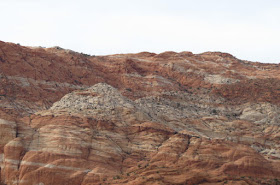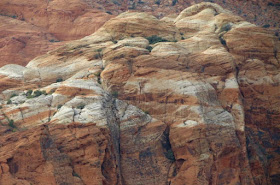Self-sufficiency and economic independence was the goal as Mormon settlers moved south of Salt Lake City due to a milder climate. Over a period of years families with varied skills were called to move into a number of settlements in order to "grow cotton" (the Cotton Mission), and although somewhat successful for a period, difficulty with the Indians, a lack of irrigation knowledge, malaria, increased process and operations, tithing, taxes, poverty... eventually led to the abandonment of it.
St. George, Utah was named after Mormon Apostle George A. Smith, founded by Apostle Erastus Snow as one of the cotton missions in 1861, and was called Dixie by Brigham Young, who was then the president of The Church of Jesus Christ of Latter-day Saints (LDS or Mormon Church).
As we drove past Dixie University, my husband read the sign "Founded 1911", and to which he responded: "105 years old, no 115, no... "
Me: "I'm not going to fight with you. You are doing a great job all by yourself." (smile)
As you get within about twenty miles of St. George, the flat and nearly barren desert of Nevada transitions into a gradual climb, and the highway snakes it's way beneath the mammoth canyon walls until you reach 2880 feet in elevation. Rainfall is less than 8 inches per year.
We arrived, settled in and enjoyed the view outside our unit.
As best we could tell, the only things stirring were a couple lizards
Our first morning was breakfast at a place we have never been_ Cracker Barrel. Eggs and bacon were good, sausage_rather spicy, while the gravy was tasteless (didn't need it anyway) and the grits were not properly cooked. As we might say, "been there twice now, first and last". But all was well.
A lightly overcast day, we walked about the beautiful and friendly city_easy access, wide streets, no paid parking, clean, inviting... very welcoming, including the crisp and chilly air.
The St. George Tabernacle (opened in 1876) was covered with scaffolding and with sand blasting underway, there was no access.
 |
| The clock was made in London |
 |
| The servant's room |
 |
| The wife's room |
 |
| Brigham Young's room |
 |
| He dined on the right, work table on the left, and at times seldom left the room due to health issues |
St. George Temple
Snow Canyon State Park (originally Dixie State Park and later renamed after Lorenzo and Erastus Snow), northwest of St George in red-rock country and just a short jaunt from our lodging, was our afternoon adventure. From sand dunes, petrified dunes (a slight reminder of cow patties) and Navajo sandstone, to ancient lava flows and cliffs of burnt orange, sienna and white, it is a natural wonder and a site to behold... along with the thrill of seeing a roadrunner.
 |
| Jenny's Canyon |
 |
| Sage |
 |
| Petrified Dunes |





































